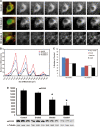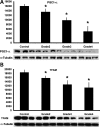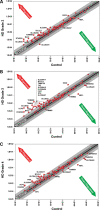Mitochondrial loss, dysfunction and altered dynamics in Huntington's disease
- PMID: 20660112
- PMCID: PMC2947400
- DOI: 10.1093/hmg/ddq306
Mitochondrial loss, dysfunction and altered dynamics in Huntington's disease
Abstract
Although a direct causative pathway from the gene mutation to the selective neostriatal neurodegeneration remains unclear in Huntington's disease (HD), one putative pathological mechanism reported to play a prominent role in the pathogenesis of this neurological disorder is mitochondrial dysfunction. We examined mitochondria in preferentially vulnerable striatal calbindin-positive neurons in moderate-to-severe grade HD patients, using antisera against mitochondrial markers of COX2, SOD2 and cytochrome c. Combined calbindin and mitochondrial marker immunofluorescence showed a significant and progressive grade-dependent reduction in the number of mitochondria in spiny striatal neurons, with marked alteration in size. Consistent with mitochondrial loss, there was a reduction in COX2 protein levels using western analysis that corresponded with disease severity. In addition, both mitochondrial transcription factor A, a regulator of mtDNA, and peroxisome proliferator-activated receptor-co-activator gamma-1 alpha, a key transcriptional regulator of energy metabolism and mitochondrial biogenesis, were also significantly reduced with increasing disease severity. Abnormalities in mitochondrial dynamics were observed, showing a significant increase in the fission protein Drp1 and a reduction in the expression of the fusion protein mitofusin 1. Lastly, mitochondrial PCR array profiling in HD caudate nucleus specimens showed increased mRNA expression of proteins involved in mitochondrial localization, membrane translocation and polarization and transport that paralleled mitochondrial derangement. These findings reveal that there are both mitochondrial loss and altered mitochondrial morphogenesis with increased mitochondrial fission and reduced fusion in HD. These findings provide further evidence that mitochondrial dysfunction plays a critical role in the pathogenesis of HD.
Figures







Similar articles
-
S-nitrosylation of dynamin-related protein 1 mediates mutant huntingtin-induced mitochondrial fragmentation and neuronal injury in Huntington's disease.Antioxid Redox Signal. 2013 Oct 10;19(11):1173-84. doi: 10.1089/ars.2012.4928. Epub 2013 Jun 20. Antioxid Redox Signal. 2013. PMID: 23641925 Free PMC article.
-
Mutant huntingtin's interaction with mitochondrial protein Drp1 impairs mitochondrial biogenesis and causes defective axonal transport and synaptic degeneration in Huntington's disease.Hum Mol Genet. 2012 Jan 15;21(2):406-20. doi: 10.1093/hmg/ddr475. Epub 2011 Oct 13. Hum Mol Genet. 2012. PMID: 21997870 Free PMC article.
-
Abnormal mitochondrial dynamics, mitochondrial loss and mutant huntingtin oligomers in Huntington's disease: implications for selective neuronal damage.Hum Mol Genet. 2011 Apr 1;20(7):1438-55. doi: 10.1093/hmg/ddr024. Epub 2011 Jan 21. Hum Mol Genet. 2011. PMID: 21257639 Free PMC article.
-
Increased mitochondrial fission and neuronal dysfunction in Huntington's disease: implications for molecular inhibitors of excessive mitochondrial fission.Drug Discov Today. 2014 Jul;19(7):951-5. doi: 10.1016/j.drudis.2014.03.020. Epub 2014 Mar 28. Drug Discov Today. 2014. PMID: 24681059 Free PMC article. Review.
-
Mutant huntingtin, abnormal mitochondrial dynamics, defective axonal transport of mitochondria, and selective synaptic degeneration in Huntington's disease.Biochim Biophys Acta. 2012 Feb;1822(2):101-10. doi: 10.1016/j.bbadis.2011.10.016. Epub 2011 Nov 4. Biochim Biophys Acta. 2012. PMID: 22080977 Free PMC article. Review.
Cited by
-
Signaling Pathways Concerning Mitochondrial Dysfunction: Implications in Neurodegeneration and Possible Molecular Targets.J Mol Neurosci. 2024 Oct 28;74(4):101. doi: 10.1007/s12031-024-02269-5. J Mol Neurosci. 2024. PMID: 39466510 Review.
-
Mitochondrial abnormalities in temporal lobe of autistic brain.Neurobiol Dis. 2013 Jun;54:349-61. doi: 10.1016/j.nbd.2013.01.006. Epub 2013 Jan 17. Neurobiol Dis. 2013. PMID: 23333625 Free PMC article.
-
Polyglutamine Tract Expansion Increases S-Nitrosylation of Huntingtin and Ataxin-1.PLoS One. 2016 Sep 22;11(9):e0163359. doi: 10.1371/journal.pone.0163359. eCollection 2016. PLoS One. 2016. PMID: 27658206 Free PMC article.
-
Shaping the role of mitochondria in the pathogenesis of Huntington's disease.EMBO J. 2012 Apr 18;31(8):1853-64. doi: 10.1038/emboj.2012.65. Epub 2012 Mar 23. EMBO J. 2012. PMID: 22446390 Free PMC article. Review.
-
Protective Effects of Antioxidants in Huntington's Disease: an Extensive Review.Neurotox Res. 2019 Apr;35(3):739-774. doi: 10.1007/s12640-018-9989-9. Epub 2019 Jan 11. Neurotox Res. 2019. PMID: 30632085 Review.
References
-
- Ferrante R.J., Beal M.F., Kowall N.W., Richardson E.P., Jr, Martin J.B. Sparing of acetylcholinesterase-containing striatal neurons in Huntington's disease. Brain Res. 1987;411:162–166. doi:10.1016/0006-8993(87)90694-9. - DOI - PubMed
-
- Hersch S.M., Rosas H.R., Ferrante R.J. Neuropathology and pathophysiology of Huntington's disease. In: Watts R.L., Koller W.C., editors. Movement Disorders: Neurologic Principles and Practice. New York, NY: McGraw-Hill; 2004. pp. 503–523.
-
- Stack E.C., Ferrante R.J. Huntington's disease: progress and potential in the field. Expert Opin. Investig. Drugs. 2007;16:1933–1953. doi:10.1517/13543784.16.12.1933. - DOI - PubMed
-
- Benard G., Bellance N., James D., Parrone P., Fernandez H., Letellier T., Rossignol R. Mitochondrial bioenergetics and structural network organization. J. Cell Sci. 2007;120:838–848. doi:10.1242/jcs.03381. - DOI - PubMed
Publication types
MeSH terms
Substances
Grants and funding
LinkOut - more resources
Full Text Sources
Other Literature Sources
Medical
Research Materials
Miscellaneous

